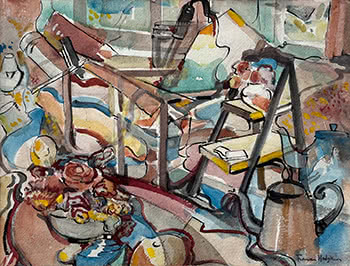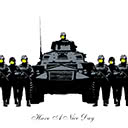Atelier, c. 1927
30 x 39 cm
est. $35,000 - 45,000
PROVENANCE
Private Collection, Wellington
REFERENCE
Frances Hodgkins database number FH0835 completefranceshodgkins.com
The 1920s was a decade of experimentation, at a time when Britain was in recession, causing many artists including Hodgkins periods of considerable hardship. Apart from two years in Manchester, which gave her a period of financial security working for the Calico Printing Association, she continued a peripatetic life, raising money through teaching and escaping to France whenever funds allowed. From June 1927 she stayed in the north of France with fellow artists Cedric Morris and Arthur Lett Haines. She experimented in gouache, producing paintings that were initially dark and fragmented, indicative of her emotional state after the death the year before of both her mother and Norman Garstin, her first mentor in France. The clouds lifting, she returned to her favoured medium of watercolour, her compositions are flooded with colour once more.
Atelier is a highly sophisticated composition. A summer work, as indicated by the bowl of flowers on the table in the foreground, Hodgkins is experimenting with the objects found in an itinerant artist's studio. Note the ghosting of a second teapot of a different shape behind the one lower right, the way objects become translucent, showing the outline of the forms behind and below. The large windows perfect for an artist cast light on the interior. An electric water boiler rests in a cup, its cord snaking down out of sight. A second bunch of flowers perhaps, sits on the top of a set of steps, and a residual frame of chair, its rush seat removed, turns its back on us in the middle ground. Three wavy stripes give the impression of a beach towel or a rug insinuating its presence in the middle ground, and random vases and jugs tilt jauntily on the left.
The title of the watercolour, apart from its obvious reference to France, suggests it was done in Tréboul, where she gave Dorothy Selby and other students classes. I would suggest that the 'clutter' of Atelier, although arranged in an unnatural manner, may suggest that objects had been set up in the room for her students to study. Furthermore, the word 'Atelier' is telling, for though it describes a studio, it also refers to the role of teaching - cf. Atelier Colarossi in Paris, where Hodgkins had studied in 1909, and where she became Paris's first woman watercolour teacher in 1910.
The vase of flowers is also important, signifying a new direction in still life that would evolve into studies out of doors, a compositional gambit that was to earn her fame in England.
Tréboul Landscape, 1927 shows a similar creative approach to delineating forms in the landscape. While the house in the background are clearly demarcated in grisaille, the foreground has an abstracted treatment, keeping us guessing as to whether we are looking at walls, rocks and a strange hybrid plant rising up before us, or whether they are influenced by something else entirely.
In September Hodgkins moved from Tréboul to Concarneau, describing the tiny room she now inhabited. One of the works painted there was Interior Scene. Once again, she depicts a chair from behind, the view from the narrow window framing the weeping branches of a tree beyond. Compared to Atelier, we sense the cramped dimensions of the interior, but the fluidity of paint for what is a sketch rather than a finished work suggests the same deftness seen in both Atelier and Tréboul Landscape.
When Rodney Wilson began on a catalogue raisonné for Frances Hodgkins , he drew on Eric McCormick's seminal research. Both included Atelier in their documentation, simply attributing the date to the 1920s.
MARY KISLER





